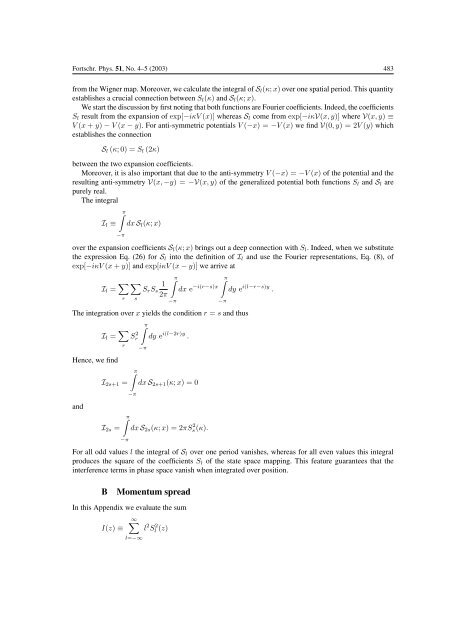Kicked rotor in Wigner phase space - The University of Texas at Austin
Kicked rotor in Wigner phase space - The University of Texas at Austin
Kicked rotor in Wigner phase space - The University of Texas at Austin
Create successful ePaper yourself
Turn your PDF publications into a flip-book with our unique Google optimized e-Paper software.
Fortschr. Phys. 51, No. 4–5 (2003) 483<br />
from the<strong>Wigner</strong> map. Moreover, wecalcul<strong>at</strong>ethe<strong>in</strong>tegral <strong>of</strong> Sl(κ; x) over one sp<strong>at</strong>ial period. This quantity<br />
establishes a crucial connection between Sl(κ) and Sl(κ; x).<br />
We start the discussion by first not<strong>in</strong>g th<strong>at</strong> both functions are Fourier coefficients. Indeed, the coefficients<br />
Sl result from the expansion <strong>of</strong> exp[−iκV (x)] whereas Sl comefrom exp[−iκV(x, y)] where V(x, y) ≡<br />
V (x + y) − V (x − y). For anti-symmetric potentials V (−x) =−V (x) wef<strong>in</strong>d V(0,y)=2V (y) which<br />
establishes the connection<br />
Sl (κ;0)=Sl (2κ)<br />
between the two expansion coefficients.<br />
Moreover, it is also important th<strong>at</strong> due to the anti-symmetry V (−x) =−V (x) <strong>of</strong> thepotential and the<br />
result<strong>in</strong>g anti-symmetry V(x, −y) =−V(x, y) <strong>of</strong> the generalized potential both functions Sl and Sl are<br />
purely real.<br />
<strong>The</strong><strong>in</strong>tegral<br />
Il ≡<br />
π<br />
−π<br />
dx Sl(κ; x)<br />
over the expansion coefficients Sl(κ; x) br<strong>in</strong>gs out a deep connection with Sl. Indeed, when we substitute<br />
theexpression Eq. (26) for Sl <strong>in</strong>to thedef<strong>in</strong>ition <strong>of</strong> Il and use the Fourier represent<strong>at</strong>ions, Eq. (8), <strong>of</strong><br />
exp[−iκV (x + y)] and exp[iκV (x − y)] wearrive<strong>at</strong><br />
Il = <br />
r<br />
s<br />
SrSs<br />
π<br />
1<br />
dx e<br />
2π<br />
−i(r−s)x<br />
π<br />
dy e i(l−r−s)y .<br />
<strong>The</strong><strong>in</strong>tegr<strong>at</strong>ion over x yields the condition r = s and thus<br />
Il = <br />
Hence, we f<strong>in</strong>d<br />
and<br />
r<br />
I2s+1 =<br />
I2s =<br />
π<br />
−π<br />
S 2 r<br />
π<br />
−π<br />
π<br />
−π<br />
−π<br />
dy e i(l−2r)y .<br />
dx S2s+1(κ; x) =0<br />
dx S2s(κ; x) =2πS 2 s (κ).<br />
−π<br />
For all odd values l the<strong>in</strong>tegral <strong>of</strong> Sl over one period vanishes, whereas for all even values this <strong>in</strong>tegral<br />
produces thesquare<strong>of</strong> thecoefficients Sl <strong>of</strong> thest<strong>at</strong>e<strong>space</strong>mapp<strong>in</strong>g. This fe<strong>at</strong>ureguarantees th<strong>at</strong> the<br />
<strong>in</strong>terference terms <strong>in</strong> <strong>phase</strong> <strong>space</strong> vanish when <strong>in</strong>tegr<strong>at</strong>ed over position.<br />
B Momentum spread<br />
In this Appendix weevalu<strong>at</strong>ethesum<br />
I(z) ≡<br />
∞<br />
l=−∞<br />
l 2 S 2 l (z)
















